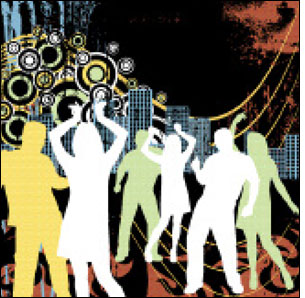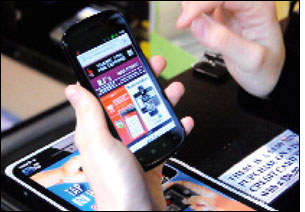Presented below is part six of an 11-part series examining the use of radio frequency identification for unexpected applications. In this chapter, we consider RFID’s use in the area of networking.
47. Connecting Marathoners and Supporters
Many racing organizations use RFID to keep track of runners and their times. The New York City Marathon is taking this service a step further. When tagged runners pass RFID readers along the 26.2-mile course, they can see and hear their family and friends rooting for them on a 20-foot LED screen. (See ASICS Uses RFID to Inspire Marathon Runners.)
|
|
48. Getting the Scoop on Ice Cream
Izzy’s Ice Cream Café, which prepares small batches of artisan varieties, has loyal customers, many of whom want to know when their favorite flavors become available. So the St. Paul, Minn., store RFID-tags ice-cream containers before they are placed in the display case, which is equipped with RFID readers. The system updates the store’s menu sign in near real time—and alerts customers on the company’s Web page, Facebook and Twitter. (See RFID Finds Flavor at Izzy’s Ice Cream Shop.)
49. Sharing Skiing Success
Vail Resorts incorporated RFID technology into its ticketing system, to make it easier for the company to check lift tickets at base-area chairlifts across its five resorts. Now, visitors can use the RFID system to track the vertical feet they skied or snowboarded—and share their statistics with friends on Facebook and Twitter. (See Vail Resorts Links RFID With Social Media.)
50. Spreading the ‘Art Is Cool’ Word
The Teen Gallery at the Centre Pompidou art museum, in Paris, invites young visitors to share their experiences with friends on social-media sites. Teens are given mobile phones with Near-Field Communication (NFC) technology, which they can wave near posters and exhibits equipped with NFC tags to gain information. The phones also can be used to post comments about the artwork, as well as videos of the artists, on Facebook and MySpace. (See Centre Pompidou Hopes NFC Will Draw Teens to Art.)
51. Having Your Feelings Count
Thousands of attendees at the 2010 STRP Festival, a 10-day event filled with art, music and technology that took place in the Netherlands city of Eindhoven, used RFID to record their reactions to dozens of interactive art installations, and to share them on Facebook and Twitter. Attendees used RFID-enabled wristbands or ID cards to log onto RFID-enabled kiosks. (See At Dutch Festival, Visitors Used RFID to Critique Art, Share Opinions.)
52. Promoting Events
Coca-Cola Village, a festival that features activities and entertainment, uses RFID to promote the event and give teenage visitors a way to automatically share details of their fun. Teens wearing RFID-enabled wristbands can connect to their Facebook pages at readers located at various attractions. (See RFID Helps Make Friends for Israeli Teens.)
53. Business Exchange
By adding RFID tags to conference badges, event managers can track room attendance and exhibitors can gather customer contact information. NASSCOM, an Indian trade association, uses event-focused RFID technology to track and serve attendees at its annual international conference in Mumbai. The system also lets participants locate and network with other delegates and exhibitors with similar interests, creating a better customer experience. At RFID Journal’s annual LIVE! event, attendees can access their Facebook accounts in real time simply by swiping their RFID-enabled conference badges at kiosks. (See Working the Room and RFID Journal LIVE! to Let Attendees Use RFID to Share Experiences Via Facebook.)
54. Mobile Media Networking
Wilkins Media Company, in Atlanta, specializes in billboards and other “out-of-home”—and cutting-edge—advertising media. “We believe mobile marketing has a very real future as a prime driver of information transfer and immediate sales,” says Dana Burleson, a Wilkins senior VP. “It is imperative to get our client partners familiar and comfortable with the different mobile technologies.”
To that end, Wilkins turned to Blue Bite, a 4-year-old New York-based startup. Blue Bite offers a Near-Field Communication (NFC) system that delivers entertaining and informative digital media content—including ads, coupons and video promotions—to mobile phone users within targeted geographic locations.
At the system’s heart is the mTag, an 8- by 5-inch adhesive placard with an embedded NFC tag that retailers, banks, movie theaters and others can easily stick on a wall, display stand, kiosk, counter or other flat surface to attract the attention of bargain-hungry mobile-phone users. Each placard features a distinctive logo and custom text, such as “tap phone here for a special offer” or “tap me to learn more.” As soon as an NFC connection is completed, the tag instructs the phone to download content from a Blue Bite server. The company’s proprietary technology then pinpoints the user’s location and pushes through targeted content that can be tailored to time, day, place, weather and other criteria.
“We’re allowing consumers and marketers to engage each other directly in an almost unlimited number of ways,” says Mikhail Damiani, Blue Bite’s co-founder and CEO. The system, already available in several San Francisco-area locations, is set to expand to more than 5,000 places nationwide during the next few months, he says.
But getting clients to dedicate scarce marketing dollars to a technology they’re only vaguely familiar with, at best, can be challenging, Burleson says. “We help them understand that the real benefits far outweigh the risk of working with new concepts,” he says. Hotels.com and The New York Times are among the companies that have already piloted the technology.
There’s a bright future for technologies that push content to mobile users, says Drew Nathanson, director of research operations for VDC Research. “I think communications between a consumer device and a tag… there is going to be significant play there,” he says.
But mobile content pushers will have to exercise restraint or risk alienating consumers, he adds. “There’s a fine line between pushing an ad and accepting an ad,” he says. “These are customer engagement technologies; you don’t want them to be customer enragement ones.”
Blue Bite understands that customers don’t want to be flooded with unrequested information, Damiani says. “We have an opt-in,” he says. “You have to physically take your phone and tap the tag—there’s no way you’ll get any content without doing that.”
While some critics have described social-media marketing as “spam with a plan,” Nathanson insists Blue Bite’s technology should be viewed as a modern, faster and richer version of the prepaid reply postcards that have been a mainstay of magazine and newspaper advertising for decades. “It’s a new way of giving people the information they want,” he says.
55. Matchmaking
While we don’t condone smoking, this might spark some ideas for healthier matchmaking applications. Blu Cigs is using RFID to help its electronic cigarette smokers connect with each other. Each pack is equipped with an active tag. The pack lights up and vibrates to indicate someone with a similar pack is nearby. (See RFID Makes Matches for E-Cigarette Smokers.)
Click here to read about RFID’s use in other unexpected applications.
Illustration: iStockphoto



